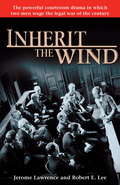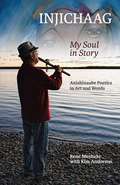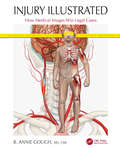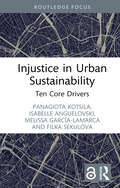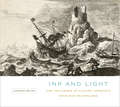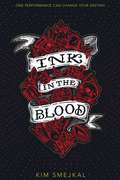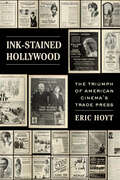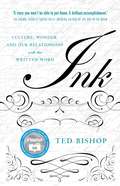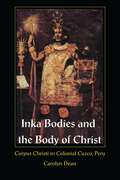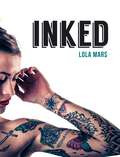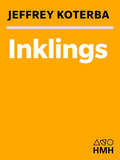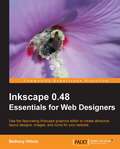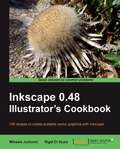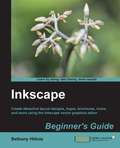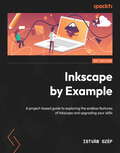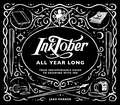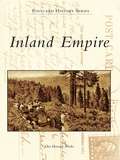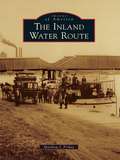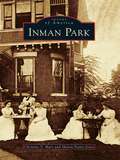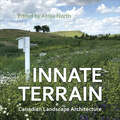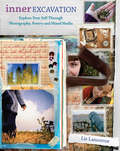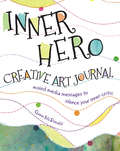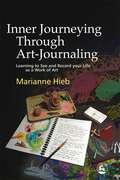- Table View
- List View
Inherit the Wind: The Powerful Courtroom Drama in which Two Men Wage the Legal War of the Century
by Robert E. Lee Jerome LawrenceThe accused was a slight, frightened man who had deliberately broken the law. His trial was a Roman circus. The chief gladiators were two great legal giants of the century. Like two bull elephants locked in mortal combat, they bellowed and roared imprecations and abuse. The spectators sat uneasily in the sweltering heat with murder in their hearts, barely able to restrain themselves. At stake was the freedom of every American. One of the most moving and meaningful plays of our generation. "a tidal wave of a drama." -- New York World-Telegram And Sun
Injichaag: Anishinaabe Poetics in Art and Words
by Rene MeshakeThis book shares the life story of Anishinaabe artist Rene Meshake in stories, poetry, and Anishinaabemowin “word bundles” that serve as a dictionary of Ojibwe poetics. Meshake was born in the railway town of Nakina in northwestern Ontario in 1948, and spent his early years living off-reserve with his grandmother in a matriarchal land-based community he calls Pagwashing. He was raised through his grandmother’s “bush university,” periodically attending Indian day school, but at the age of ten Rene was scooped into the Indian residential school system, where he suffered sexual abuse as well as the loss of language and connection to family and community. This residential school experience was lifechanging, as it suffocated his artistic expression and resulted in decades of struggle and healing. Now in his twenty-eighth year of sobriety, Rene is a successful multidisciplinary artist, musician and writer. Meshake’s artistic vision and poetic lens provide a unique telling of a story of colonization and recovery. The material is organized thematically around a series of Meshake’s paintings. It is framed by Kim Anderson, Rene’s Odaanisan (adopted daughter), a scholar of oral history who has worked with Meshake for two decades. Full of teachings that give a glimpse of traditional Anishinaabek lifeways and worldviews, Injichaag: My Soul in Story is “more than a memoir.”
Injury Illustrated: How Medical Images Win Legal Cases
by R. Annie GoughThe best storytellers and presenters know that a picture is worth a thousand words. Pictures simplify stories. They make stories memorable. They clarify complex concepts and they educate the audience in the easiest way. That is why attorneys work with artists—medical illustrators, to be exact. Injury Illustrated is the first book of its kind. It is the essential guide on medical illustrations used in the legal context. This book examines the creation of visual graphics known as demonstrative exhibits. These exhibits provide an understanding of traumatic injuries, surgeries, and radiology studies for the jury, judges, adjustors, mediators, and the attorneys. These chapters describe how to tell a clear story about gross anatomy, medical malpractice, and/or death investigation in court by using medical images. While medical illustration and injury law are very different professions, illustrators are the ideal partners for lawyers when solving problems and preparing for litigation. Divided into five sections, this book details who medical illustrators are, how they are educated in medicine, the skills and services they can provide to trial lawyers, and the countless benefits resulting from record review and case preparation. Find techniques to best use medical images during all stages of litigation Learn how graphic exhibits engage a jury and empower justice Understand why attorneys win more cases by collaborating with medical illustrators All readers will learn about this unique career and the attorney-illustrator relationship. More specifically, attorneys, artists, animators, law students, medical students, forensic scientists, and medical experts will understand how demonstrative exhibits assist legal proceedings in forensic matters and civil lawsuits. Warning; these images will be graphic and the cases at times will be catastrophic.
Injustice in Urban Sustainability: Ten Core Drivers (Routledge Equity, Justice and the Sustainable City series)
by Isabelle Anguelovski Panagiota Kotsila Melissa García-Lamarca Filka SekulovaThis book uses a unique typology of ten core drivers of injustice to explore and question common assumptions around what urban sustainability means, how it can be implemented, and how it is manifested in or driven by urban interventions that hinge on claims of sustainability. Aligned with critical environmental justice studies, the book highlights the contradictions of urban sustainability in relation to justice. It argues that urban neighbourhoods cannot be greener, more sustainable and liveable unless their communities are strengthened by the protection of the right to housing, public space, infrastructure and healthy amenities. Linked to the individual drivers, ten short empirical case studies from across Europe and North America provide a systematic analysis of research, policy and practice conducted under urban sustainability agendas in cities such as Barcelona, Glasgow, Athens, Boston and Montréal, and show how social and environmental justice is, or is not, being taken into account. By doing so, the book uncovers the risks of continuing urban sustainability agendas while ignoring, and therefore perpetuating, systemic drivers of inequity and injustice operating within and outside of the city. Accessibly written for students in urban studies, critical geography and planning, this is a useful and analytical synthesis of issues relating to urban sustainability, environmental and social justice.
Ink and Light
by Andrew BrinkClaude Lorrain (1600-1682), an eminent seventeenth-century landscape painter, was an equally talented graphic artist. Lorrain's etchings match the mastery and execution of his paintings and yet are largely unrecognized by contemporary collectors and art historians. Andrew Brink, an astute and discriminating art collector, amassed an impressive collection of etchings, engravings, and mezzotints by European master printmakers from the sixteenth century onwards. The keystone works in the Brink Collection, now housed in Guelph, Ontario's Macdonald Stewart Art Centre, are by Claude Lorrain. In Ink and Light, Brink positions Lorrain's prints as seminal to the establishment of seventeenth- and eighteenth-century aesthetics in England, which gave rise to the English pictorialism in art and landscape architecture that would have international influence in the nineteenth and twentieth centuries. He discusses the technical and material character of Lorrain's etchings, as well as their connection to literature and philosophy in early modern times. While Brink's main focus is the impact of the etchings, he also looks at paintings and drawings by Lorrain, in addition to works made by other artists after Lorrain. Featuring forty of Claude Lorrain's etchings from the Brink Collection, Ink and Light fills a significant gap in British art history by providing a close reading of Lorrain's prints, their reception in England, and the enduring impact they had on a distinctive British aesthetic.
Ink and Light: The Influence of Claude Lorrain's Etchings on England
by Andrew BrinkClaude Lorrain (1600-1682), an eminent seventeenth-century landscape painter, was an equally talented graphic artist. Lorrain's etchings match the mastery and execution of his paintings and yet are largely unrecognized by contemporary collectors and art historians. Andrew Brink, an astute and discriminating art collector, amassed an impressive collection of etchings, engravings, and mezzotints by European master printmakers from the sixteenth century onwards. The keystone works in the Brink Collection, now housed in Guelph, Ontario's Macdonald Stewart Art Centre, are by Claude Lorrain. In Ink and Light, Brink positions Lorrain's prints as seminal to the establishment of seventeenth- and eighteenth-century aesthetics in England, which gave rise to the English pictorialism in art and landscape architecture that would have international influence in the nineteenth and twentieth centuries. He discusses the technical and material character of Lorrain's etchings, as well as their connection to literature and philosophy in early modern times. While Brink's main focus is the impact of the etchings, he also looks at paintings and drawings by Lorrain, in addition to works made by other artists after Lorrain. Featuring forty of Claude Lorrain's etchings from the Brink Collection, Ink and Light fills a significant gap in British art history by providing a close reading of Lorrain's prints, their reception in England, and the enduring impact they had on a distinctive British aesthetic.
Ink in the Blood (Ink in the Blood Duology #1)
by Kim SmejkalA lush, dark YA fantasy debut that weaves together tattoo magic, faith, and eccentric theater in a world where lies are currency and ink is a weapon, perfect for fans of Leigh Bardugo and Kendare Blake. Celia Sand and her best friend, Anya Burtoni, are inklings for the esteemed religion of Profeta. Using magic, they tattoo followers with beautiful images that represent the Divine&’s will and guide the actions of the recipients. It&’s considered a noble calling, but ten years into their servitude Celia and Anya know the truth: Profeta is built on lies, the tattooed orders strip away freedom, and the revered temple is actually a brutal, torturous prison. Their opportunity to escape arrives with the Rabble Mob, a traveling theater troupe. Using their inkling abilities for performance instead of propaganda, Celia and Anya are content for the first time . . . until they realize who followed them. The Divine they never believed in is very real, very angry, and determined to use Celia, Anya, and the Rabble Mob&’s now-infamous stage to spread her deceitful influence even further. To protect their new family from the wrath of a malicious deity and the zealots who work in her name, Celia and Anya must unmask the biggest lie of all—Profeta itself.
Ink-Stained Hollywood: The Triumph of American Cinema’s Trade Press
by Eric HoytA free open access ebook is available upon publication. Learn more at www.luminosoa.org. For the first half of the twentieth century, no American industry boasted a more motley and prolific trade press than the movie business—a cutthroat landscape that set the stage for battle by ink. In 1930, Martin Quigley, publisher of Exhibitors Herald, conspired with Hollywood studios to eliminate all competing trade papers, yet this attempt and each one thereafter collapsed. Exploring the communities of exhibitors and creative workers that constituted key subscribers, Ink-Stained Hollywood tells the story of how a heterogeneous trade press triumphed by appealing to the foundational aspects of industry culture—taste, vanity, partisanship, and exclusivity. In captivating detail, Eric Hoyt chronicles the histories of well-known trade papers (Variety, Motion Picture Herald) alongside important yet forgotten publications (Film Spectator, Film Mercury, and Camera!), and challenges the canon of film periodicals, offering new interpretative frameworks for understanding print journalism’s relationship with the motion picture industry and its continued impact on creative industries today.
Ink: Culture, Wonder, and Our Relationship with the Written Word
by Ted BishopA rich and imaginative discovery of how ink has shaped culture and why it is here to stay.Ink is so much a part of daily life that we take it for granted, yet its invention was as significant as the wheel. Ink not only recorded culture, it bought political power, divided peoples, and led to murderous rivalries. Ancient letters on a page were revered as divine light, and precious ink recipes were held secret for centuries. And, when it first hit markets not so long ago, the excitement over the disposable ballpoint pen equalled that for a new smartphone--with similar complaints to the manufacturers. Curious about its impact on culture, literature, and the course of history, Ted Bishop sets out to explore the story of ink. From Budapest to Buenos Aires, he traces the lives of the innovators who created the ballpoint pen--revolutionary technology that still requires exact engineering today. Bishop visits a ranch in Utah to meet a master ink-maker who relishes igniting linseed oil to make traditional printers' ink. In China, he learns that ink can be an exquisite object, the subject of poetry, and a means of strengthening (or straining) family bonds. And in the Middle East, he sees the world's oldest Qur'an, stained with the blood of the caliph who was assassinated while reading it. An inquisitive and personal tour around the world, Ink asks us to look more closely at something we see so often that we don't see it at all.
Inka Bodies and the Body of Christ: Corpus Christi in Colonial Cuzco, Peru
by Carolyn J DeanIn Inka Bodies and the Body of Christ Carolyn Dean investigates the multiple meanings of the Roman Catholic feast of Corpus Christi as it was performed in the Andean city of Cuzco after the Spanish conquest. By concentrating on the era's paintings and its historical archives, Dean explores how the festival celebrated the victory of the Christian God over sin and death, the triumph of Christian orthodoxy over the imperial Inka patron (the Sun), and Spain's conquest of Peruvian society. As Dean clearly illustrates, the central rite of the festival--the taking of the Eucharist--symbolized both the acceptance of Christ and the power of the colonizers over the colonized. The most remarkable of Andean celebrants were those who appeared costumed as the vanquished Inka kings of Peru's pagan past. Despite the subjugation of the indigenous population, Dean shows how these and other Andean nobles used the occasion of Corpus Christi as an opportunity to construct new identities through tinkuy, a native term used to describe the conjoining of opposites. By mediating the chasms between the Andean region and Europe, pagans and Christians, and the past and the present, these Andean elites negotiated a new sense of themselves. Dean moves beyond the colonial period to examine how these hybrid forms of Inka identity are still evident in the festive life of modern Cuzco. Inka Bodies and the Body of Christ offers the first in-depth analysis of the culture and paintings of colonial Cuzco. This volume will be welcomed by historians of Peruvian culture, art, and politics. It will also interest those engaged in performance studies, religion, and postcolonial and Latin American studies.
Inked: The World’s Most Impressive, Unique and Innovative Tattoos
by Lola MarsInked brings you a stunning collection of the most intricate, unique and exquisite tattoos, from the subtle and delicate to one-of-a-kind whole-body pieces. Showcasing a range of innovative new styles as well as traditional designs, and packing a punch of colour and charisma, every one of the tattoos in this book is proof that a tattoo is not just ink; it’s art.
Inked: The World’s Most Impressive, Unique and Innovative Tattoos
by Lola MarsInked brings you a stunning collection of the most intricate, unique and exquisite tattoos, from the subtle and delicate to one-of-a-kind whole-body pieces. Showcasing a range of innovative new styles as well as traditional designs, and packing a punch of colour and charisma, every one of the tattoos in this book is proof that a tattoo is not just ink; it’s art.
Inklings
by Jeffrey KoterbaWhen Jeffrey Koterba was six, he started drawing his first cartoons, painstakingly copying from the Sunday Omaha World Herald's funny papers and making up his own characters. With a pen and a sheet of white paper, he was able to escape into a world that was clean, expansive, and comfortable-a refuge from the pandemonium surrounding him.The tiny house Koterba grew up in was full-to-bursting with garage-sale treasures and televisions his father Art repaired and sold for extra money. A hard-drinking one-time jazz drummer whose big dreams never seemed to come true, Art was subject to violent facial and vocal tics-symptoms of Tourette's Syndrome, a condition Jeffrey inherited-as well as explosions of temper and eccentricity that kept the Koterba family teetering on the brink of disaster.From the canyons of broken electronics, the lightning strikes, screaming matches, and discouragements great and small emerged a young man determined to follow his creative spirit to grand heights. And much to his surprise, he found himself on a journey back to his family and the father he once longed to escape. An exuberant, heart-felt memoir that calls to mind The Tender Bar and Fun Home, Inklings is infused with an irresistible optimism all its own.
Inkscape 0.48 Essentials for Web Designers
by Bethany HiitolaThis book is written in a clear conversational style, which emphasizes a practical learn-by-doing approach. Packed with illustrations and examples, this book will make the task of using Inkscape simple and straightforward.This book is written for web designers who want to add attractive visual elements to their website. It assumes no previous knowledge of Inkscape. General familiarity with vector graphics programming is recommended but not required. It will also be a useful guide for experienced Inkscape users who want to learn how to apply their skills to website design.
Inkscape 0.48 Illustrator's Cookbook
by Rigel Di Scala Mihaela JurkoviEach recipe comprises step-by-step instructions followed by an analysis of what was done in each task and other useful information. The book is designed so that you can read it chapter by chapter, or look at the list of recipes and refer to them in no particular order. It is packed with useful screenshots to make your learning even easier.This book is written for both beginners and developers who have a basic knowledge of Inkscape. With this book illustrators who have just started using Inkscape can quickly dive into the world of Inkscape and graphics editing. Software developers and web designers can learn how to create graphics for their software on their own or build SVG and other web-based interfaces. Users of other graphics editing applications can find out how Inkscape can be used as an alternative to solve common graphics problems.
Inkscape Beginner’s Guide
by Bethany HiitolaAs part of Packt's Beginner's Guide series, each chapter covers an aspect of working with Inkscape, with plenty of screenshots and practical examples. This book is intended for beginning graphic and web designers who want to expand their graphic software expertise. General familiarity with a graphics program is recommended, but not required.
Inkscape by Example: A project-based guide to exploring the endless features of Inkscape and upgrading your skills
by Istvan SzepExplore and implement the capabilities of Inkscape through a variety of projects and get the hang of all the tasks a vector designer should do without having to pay a dimeKey FeaturesLearn Inkscape by building end-to-end projectsEmbrace the power of Inkscape and other open source tools to build professional projectsUse the Inkscape software at a professional level in your everyday tasks as an artistBook DescriptionGrowing into its final form after years of development, Inkscape now rivals industry leaders like Illustrator and CorelDraw – this versatile free vector graphics editor program has all the capabilities of paid software and is ready for professional use. While there are plenty of resources for beginners, this book will enable you to uncover the full potential of the tool through sample projects and tutorials. With Inkscape by Example, you'll understand how this one-stop solution helps vector designers meet all their requirements. Starting with an introduction to the new tools and features of Inkscape 1.0, you'll master the software by working through a chain of real-world projects. The book will guide you through creating an icon set and understanding modularity in vector design. As you advance, you'll draw a detailed illustration every client is looking for and learn about photo editing and creating a logo in Inkscape, combining all of these into one single web design project. Finally, you'll discover tips for working faster with SVG and XML and using Inkscape with other free tools to reach maximum workflow and creativity. By the end of this Inkscape book, you'll have developed the skills to create your own solutions for any project confidently.What you will learnCreate your own professional solutions following the project blueprints in this bookIntegrate Inkscape and other free design programs in a professional workflow efficientlyUse Inkscape for more than illustration - design a logo, edit photos, and even design websites in vectorGet to grips with troubleshooting, export the proper format, and find and correct errors in vector filesGain no-fluff practical knowledge of the tools in Inkscape and vector design methodsBroaden your understanding of the fundamentals of vector designingWho this book is forThis book showcases several projects suitable for graphic designers, UI designers, illustrators, art directors, digital artists, and other creative professionals looking to elevate their Inkscape skills. Basic knowledge of Inkscape, along with a base in graphic design, is expected.
Inktober All Year Long: Your Indispensable Guide to Drawing with Ink
by Jake ParkerThe Inktober Handbook is the definitive guide to drawing in ink from Inktober founder Jake Parker.This book offers veteran inkists and novice practitioners alike the resources they need to reach the finish line of a month-long drawing challenge—any time of year!From nuts-and-bolts drawing instruction to advice on overcoming the urge to quit, this practical paperback is perfect for anyone looking to take their drawing to the next level.• The instructive and inspirational guide fans have been waiting for• Has a unique black-dyed fore-edge, making it a great gift• Features Parker's whimsical illustrationsEvery October, people worldwide take up the challenge to complete one ink drawing a day for 31 days.The creative marathon Inktober has helped millions of artists of all skill levels master the tools and techniques of ink drawing.• A helpful and accessible guide to illustrators of all levels• Parker combines his enthusiasm for pen-and-ink drawing with encouragement and practical instruction.• Perfect gift for artists who want to practice regularly and love a challenge, pen-and-ink enthusiasts, and anyone looking to sharpen their drawing skills
Inland Empire
by John Howard WeeksSouthern California's vast Inland Empire is one of the fastest growing regions of the United States. It is a wonderland of old-growth vineyards, citrus groves, hot-water resorts, Wild West landmarks, and Native American territories. America's fabled Mother Road, Route 66, runs right through it. Its fertile valleys are encircled by mountains with famous resort areas such as Idyllwild, Big Bear Lake, and Lake Arrowhead. Those mountains are surrounded in turn by some of the world's best-known desert resort and recreational areas, including Palm Springs, the Mojave, Death Valley, and Joshua Tree National Park. Inland Empire is the first book of its kind, offering a postcard-perfect grand tour of the entire region.
Inland Water Route, The (Images of America)
by Matthew J. FridayFrom its humble beginnings as a trading route for Native Americans, Northern Michigan's Inland Route has become one of the most scenic and memorable voyages anywhere in America. As a series of interconnected lakes and rivers from Cheboygan to Conway, the Inland Route touches several Northern Michigan communities and links them through her winding rivers and vast lakes. After improvements to the waterway in the 1870s, bigger boats and log booms started drifting down the route; but what once was a necessity for fur traders and lumbermen, the meandering waterway soon blossomed with dozens of tourist boats, hotels, resorts, and cottages. The result was a memorable voyage filled with natural beauty, recreation, and socialization.
Inman Park (Images of America)
by Christine V. Marr Sharon Foster JonesThe story of Inman Park, Atlanta's first planned suburb, is one closely tied with transportation ingenuity, trade, and the progressive determination of its citizens. Situated two miles east of downtown Atlanta, Inman Park was farmland when the Civil War ravaged its rolling hills. In the 1890s, Inman Park bloomed into Atlanta's first residential park, the location of choice for Atlanta's social elite. The growth of Atlanta, however, struck a blow to the development of this utopian suburb. By the mid-20th century, the suburb fell into dilapidation, abandoned by the prominent families of Atlanta. It was not until the 1970s that the neighborhood, like Atlanta itself, was raised from its ashes to become the celebrated example of Victorian restoration that it is today and was added to the National Register of Historic Places.
Innate Terrain: Canadian Landscape Architecture
by Alissa NorthInnate Terrain addresses the varied perceptions of Canada’s natural terrain, framing the discussion in the context of landscapes designed by Canadian landscape architects. This edited collection draws on contemporary works to theorize a distinct approach practiced by Canadian landscape architects from across the country. The essays – authored by Canadian scholars and practitioners, some of whom are Indigenous or have worked closely with Indigenous communities – are united by the argument that Canadian landscape architecture is intrinsically linked to the innate qualities of the surrounding terrain. Beautifully illustrated, Innate Terrain aims to capture distinct regional qualities that are rooted in the broader context of the Canadian landscape.
Inner Excavation: Exploring Your Self Through Photography, Poetry and Mixed Media
by Liz Lamoreux Tonia DavenportExpress the art within you There are clues all around you - sounds, textures, memories, passions - just waiting for you to shine a light on them, and unearth the most intimate form of expression - the self-portrait. Inside Inner Excavation, author Liz Lamoreux will be your guide, along with eleven inspiring artists, as you discover more about who you are, how you got here and where you wish to go. Prompts and exercises will show you how to express who you are through the photos you take, the words you write and the art you create. Find encouragement and fresh ideas in these pages as you: Uncover prompts to use your senses for exploring and capturing where you are in any particular moment. Tap into the poet's voice that's whispering inside of you, even if you've never written poetry before. Be given permission to spend time "Delving into the Quiet," being still and listening to the mindful voice inside of you through meditation to create a balance in your daily moments. Bring words and art together in self-portrait expression that is as layered as you are. Take a fresh look inside today; become inspired, through Inner Excavation, to see more than the smiling reflection in the mirror.
Inner Hero Creative Art Journal: Mixed Media Messages to Silence Your Inner Critic
by Quinn McdonaldDear Inner Critic, meet your inner heroes! As a creative person, you are familiar with the critic--that nagging presence in your head that is always trying to point out your shortcomings. But there is hope: Your inner heroes are also always with you at your worktable. Through the creation of your personal Inner Hero Creative Art Journal (a series of loose-leaf cards, each with a new mixed-media technique), you will invite an inner conversation that will illuminate your best self. Your inner Scribe, Tarot Reader, Alchemist, Gardener and Wise Woman each long to be introduced to your inner critic and to show you a positive and more supportive perspective. Those who wish to step up to their inner critic will soon hear a gentler voice. Overcome negative self-talk--Each chapter introduces a variety of ideas and exercises to release your inner heroes. Discover a new format--Loose-leaf watercolor pages become art-journaled cards you will use over and over again to make meaning of your journey. Mixed media techniques--Discover art-making techniques using inks, photos, watercolors, fabric, eggshells and more to use in your own art journaling. Additional online content--Links to downloadable worksheets and inspiring variations are sprinkled throughout the book. Step out of the critic's shade and into the warmth and comfort of your own creative light.
Inner Journeying Through Art-Journaling: Learning to See and Record your Life as a Work of Art
by Marianne HiebInner Journeying Through Art-Journaling introduces a holistic journaling process that combines art, art therapy, design theory and spiritual direction in order to attain personal balance, awareness of one's own inner processes, resolution of internal conflicts and enhanced wellness. The book guides the reader through the process of creative journaling and presents the key elements of the technique. Case studies and art journals of Marianne Hieb's own clients and retreat participants show the effectiveness of journaling as a therapeutic intervention and as a meditative tool. Inner Journeying Through Art-Journaling will be of significant use to anyone interested in holistic healing, and of special interest to arts therapists, counsellors, spiritual directors, and anyone dealing with people who are encountering loss, grief, resistance, or discernment issues. It will also be helpful for the individual looking to add holistic journaling to his or her own meditation, prayer, or inner exploration practice.
